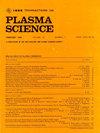用外延曲线理论分析空间谐波磁控管中的电子轨迹
IF 1.5
4区 物理与天体物理
Q3 PHYSICS, FLUIDS & PLASMAS
引用次数: 0
摘要
本文介绍了在设计的空间谐波磁控管(SHM)的边界条件下应用表斜曲线理论研究和分析电子轨迹的方法。基于表斜曲线理论建立了一个模型,用推导的方程研究了粒子/点的轨迹,从一个基本的理论框架上对磁控管的理解提供了见解。分析了该理论的常数,即“a”、“b”、“h”及其相互关系。常数“a”控制膨胀半径,与直流电压有关;常数“b”控制旋转半径,与磁场有关;常数“h”控制轨迹的周期性和摄动,与射频电压有关。该模型提供了一些推导方程,使这些常数在所设计的SHM边界约束内的映射能够理解磁控管和SHM中的某些重要现象。该模型的边界条件解提供了常数的初步猜测,并通过径向展开研究和轨迹分析进一步优化。生成的电子中心轨迹表明,当旋转径向矢量rtot < rm平均半径时,阴极的电子反轰击现象占主导地位,当静止径向矢量rstat < > rm平均半径时,阳极的电流收集占主导地位。因此,该模型突出了平均半径的重要性,优化了径向膨胀常数“a”和“b”与射频常数“h”的比值,对磁控管物理的工作起着重要的作用。利用该模型得到了22条轮辐的最优参数为:amax = 1.2342, amin = 0.6996, bmax = 0.0561, bmin = 0.0318, hmax $= \pm 0.2960$, hmin $= =\pm 0.0080$。本文章由计算机程序翻译,如有差异,请以英文原文为准。
Electron Trajectories Analysis in Spatial Harmonic Magnetrons Using Epitrochoidal Curve Theory
The manuscript presents the implementation of epitrochoidal curve theory for the study and analysis of electron trajectories in the boundary conditions of the designed spatial harmonic magnetron (SHM). A model is created based on the epitrochoidal curve theory to study the trajectories of a particle/point with derived equations, offering insights into the understanding of magnetrons by a fundamental theoretical framework. The constants of the theory, namely “a,” “b,” “h,” and their correlation, have been analyzed. Constant “a” controls the expansion radius and thus relates to the dc voltage, constant “b” controls the gyration radius and relates to the magnetic field, and constant “h” controls the periodicity and perturbation of the trajectories and thus relates to the RF voltage. The model provides some derived equations enabling the mapping of these constants within the boundary constraints of the designed SHM to understand certain important phenomena in magnetrons and SHMs. The boundary condition solutions from the model provide the initial guesses of constants, which are further optimized by radial expansion study and trajectory analysis. The trajectories of the generated electron hub reveal the dominance of electron backbombardment phenomena at the cathode when the rotational radial vector rtot < rm mean radius, and anode current collection domination when the stationary radial vector rstat > rm mean radius. Thus, the model highlights the significance of the mean radius and optimizes the ratio of radial expansion constants “a” and “b” and the RF constant “h,” which plays a significant role in the working of magnetron physics. Using the model, the optimum values of the parameters for 22 spokes in SHM have been obtained as amax = 1.2342, amin = 0.6996, bmax = 0.0561, bmin = 0.0318, hmax $= \pm 0.2960$ , and hmin $= =\pm 0.0080$ .
求助全文
通过发布文献求助,成功后即可免费获取论文全文。
去求助
来源期刊

IEEE Transactions on Plasma Science
物理-物理:流体与等离子体
CiteScore
3.00
自引率
20.00%
发文量
538
审稿时长
3.8 months
期刊介绍:
The scope covers all aspects of the theory and application of plasma science. It includes the following areas: magnetohydrodynamics; thermionics and plasma diodes; basic plasma phenomena; gaseous electronics; microwave/plasma interaction; electron, ion, and plasma sources; space plasmas; intense electron and ion beams; laser-plasma interactions; plasma diagnostics; plasma chemistry and processing; solid-state plasmas; plasma heating; plasma for controlled fusion research; high energy density plasmas; industrial/commercial applications of plasma physics; plasma waves and instabilities; and high power microwave and submillimeter wave generation.
 求助内容:
求助内容: 应助结果提醒方式:
应助结果提醒方式:


